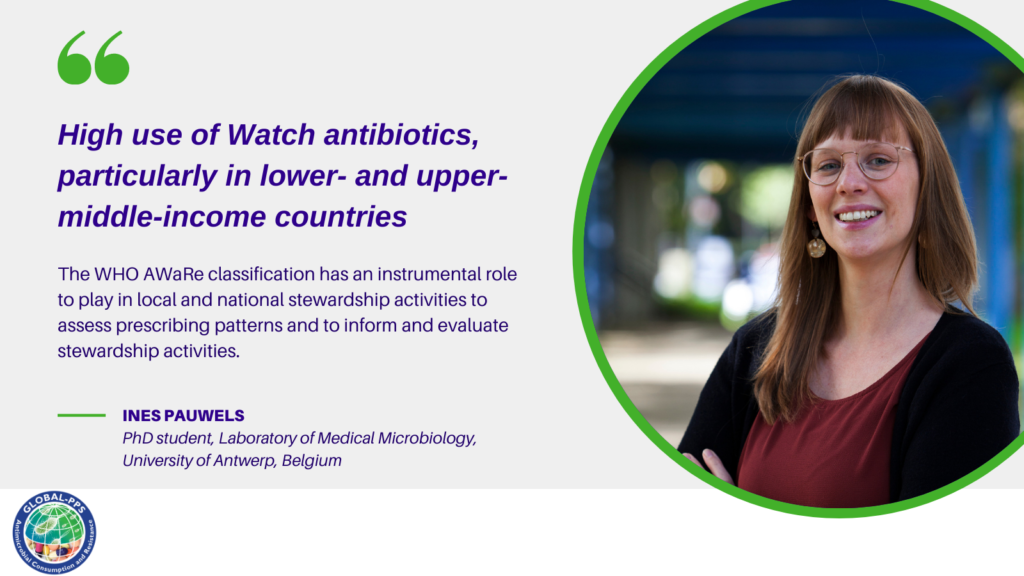High use of Watch antibiotics in hospitals in lower- and upper-middle-income countries
 On 5 April 2021, the Global-PPS team published a paper in the Journal of Antimicrobial Chemotherapy that focuses on hospital antibiotic prescribing patterns in adult patients according to the WHO Access, Watch and Reserve classification (AWaRe). This classification has been developed to support countries and hospitals in promoting rational use of antibiotics while improving access to these essential medicines.
On 5 April 2021, the Global-PPS team published a paper in the Journal of Antimicrobial Chemotherapy that focuses on hospital antibiotic prescribing patterns in adult patients according to the WHO Access, Watch and Reserve classification (AWaRe). This classification has been developed to support countries and hospitals in promoting rational use of antibiotics while improving access to these essential medicines.
Antimicrobial resistance is a concrete threat: global antibiotic consumption in the healthcare sector increased by 65% between 2000 and 2015. Optimizing antimicrobial use in hospital and community settings through antimicrobial stewardship (AMS) is considered a key element in the global AMR response. At the same time, many low- and middle-income countries (LMICs) are confronted with challenges such as poor quality of antibiotics, loosely regulated over-the-counter sales and limited access to essential antibiotics. WHO classified a total of 180 antibiotics available worldwide into three groups: Access, Watch and Reserve (AWaRe).
Antibiotics in the Access group are considered as first- or second-line agents in the treatment of a number of common infectious syndromes and should therefore be widely available and affordable. The Watch group includes antibiotics that have a higher risk of selecting for resistance and that are used as first- or second-line options for a limited number of indications only. These are the antibiotics that need to be monitored and prioritized as targets for stewardship programmes. Finally, the Reserve group contains a set of last-resort antibiotics that need to be intensively monitored and should only be used under certain specific conditions in order to conserve their effectiveness.
 The Global Point Prevalence Survey on Antimicrobial Consumption and Resistance (Global-PPS) collects hospital antibiotic use data using a standardized PPS methodology. Global-PPS 2015, 2017 and 2018 data, collected by 664 hospitals in 69 countries, were categorized into AWaRe groups to calculate proportional AWaRe use, Access-to-Watch ratios and the most common indications for treatment with selected Watch antibiotics. Only prescriptions for systemic antibiotics on adult inpatient wards were analysed.
The Global Point Prevalence Survey on Antimicrobial Consumption and Resistance (Global-PPS) collects hospital antibiotic use data using a standardized PPS methodology. Global-PPS 2015, 2017 and 2018 data, collected by 664 hospitals in 69 countries, were categorized into AWaRe groups to calculate proportional AWaRe use, Access-to-Watch ratios and the most common indications for treatment with selected Watch antibiotics. Only prescriptions for systemic antibiotics on adult inpatient wards were analysed.
Regional Access use ranged from 28.4% in West and Central Asia to 57.7% in Oceania, whereas Watch use was lowest in Oceania (41.3%) and highest in West and Central Asia (66.1%). Reserve use ranged from 0.03% in sub-Saharan Africa to 4.7% in Latin America. There were large differences in AWaRe prescribing at country level. Watch antibiotics were prescribed for a range of very different indications worldwide, both for therapeutic and prophylactic use.
The Global-PPS team observed high use of Watch antibiotics, particularly in lower- and upper-middle-income countries, followed by high-income countries. The WHO AWaRe classification has an instrumental role to play in local and national stewardship activities to assess prescribing patterns and to inform and evaluate stewardship activities.
